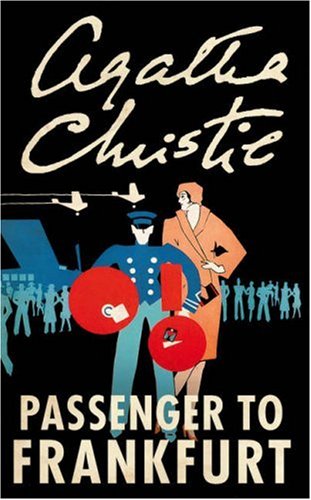
“Where do you get your ideas from?” Agatha Christie ponders in the introduction. This bold, mad romp is isn't so much inspired as improvised, changing tack, plot and characters from page to page.
This would matter more if it wasn't so bloody entertaining from moment to moment. It's only as you approach the end that you think “No, now, hang on a minute, this isn't fair...”
We start with Sir Stafford Nye – a diplomat who, we are assured, would go far except for his addiction to jokes. This is surprising as he tells Not One Joke throughout the entire book. He's a game old bird and enters into an intrigue with the mysterious Passenger To Frankfurt, becoming involved in an international conspiracy which is thrillingly described and then.... peters out oddly.
We switch several times to the rooms of some high-powered diplomats, some of them vividly described in clouds of cigar smoke, some of them utterly faceless (one of them's a villain, by the way, but when they're unmasked you'll have a great moment of “uh, who is that again?”).
We then switch away to Stafford's marvellous octogenarian Aunt Matilda. She's a wily old bird and has realised that there's a conspiracy afoot To Destroy Civilisation. So she promptly goes on holiday to Bavaria, where she encounters the conspirators, among them a very fat lady, Hitler's Son, and what appears to be the SS who are taking over the young of the world by organising some nice concerts with decent catering. Crikey.
Poor Sir Stafford wanders back in and then potters out like he's forgotten his keys. At one moment he laments that “Fiction was infinitely superior to real life”, which all depends on your point of view. He's frequently either clutching an enigmatic stuffed panda or a glamorous young woman/princess. Who he may or may not be in love with, who may or may not be related to him, who may or may not be about to destroy the world. Occasionally he plays Wagner on the recorder and who can blame him?
That this all makes sense as you're reading it (but not immediately afterwards) is quite a tribute to Christie. She's an utter poppet for wonderful diversions, such as Aunt Matilda remembering that as a child she wasn't allowed to read novels in the morning, and who hints thickly (and entirely erroneously) that the mystery hinges on The Prisoner Of Zenda.
Occasionally we'll hear that Washington has been destroyed by rioting children, or that planes are being hijacked and taken to Africa. A figure somewhat like General de Gaul will take to the streets of Paris in an attempt to quell the uprising, but it's all too complicated and sometimes has a bit to do with biological warfare and sometimes to do with the destruction of all the airports across Europe. There's even a diagram of the conspiracy, which really doesn't help at all, but looks a bit like a flower. Which is pretty.
There's a remarkable scene recalled in an insane asylum featuring Hitler talking to some Hitler impersonators, which may go some way towards explaining the diabolical schemes of a large woman called Charlotte. Then again, it may not, as contradictory explanations are given – frequently and bafflingly.
It ends in a remote house in Scotland where the solution is... well, only possible to wor out if you've been paying very close attention. And even then, it's quite remarkably odd, like late Margery Allingham doing battle with GK Chesterton sieved through a worn sock. But there's a wedding, although quite why that happens isn't explained.
It's a lovely, maddening pudding of a book. That you'll love a bit despite yourself. Notice the interesting cover of the current edition – the book itself is like the 1920s trying to engage with a world of punk and flower power. But the book cover tuts and goes for some nice frocks. And bless it for that.
We also never find out the significance of the stuffed panda.
NEXT: Why didn't they ask Evans?

